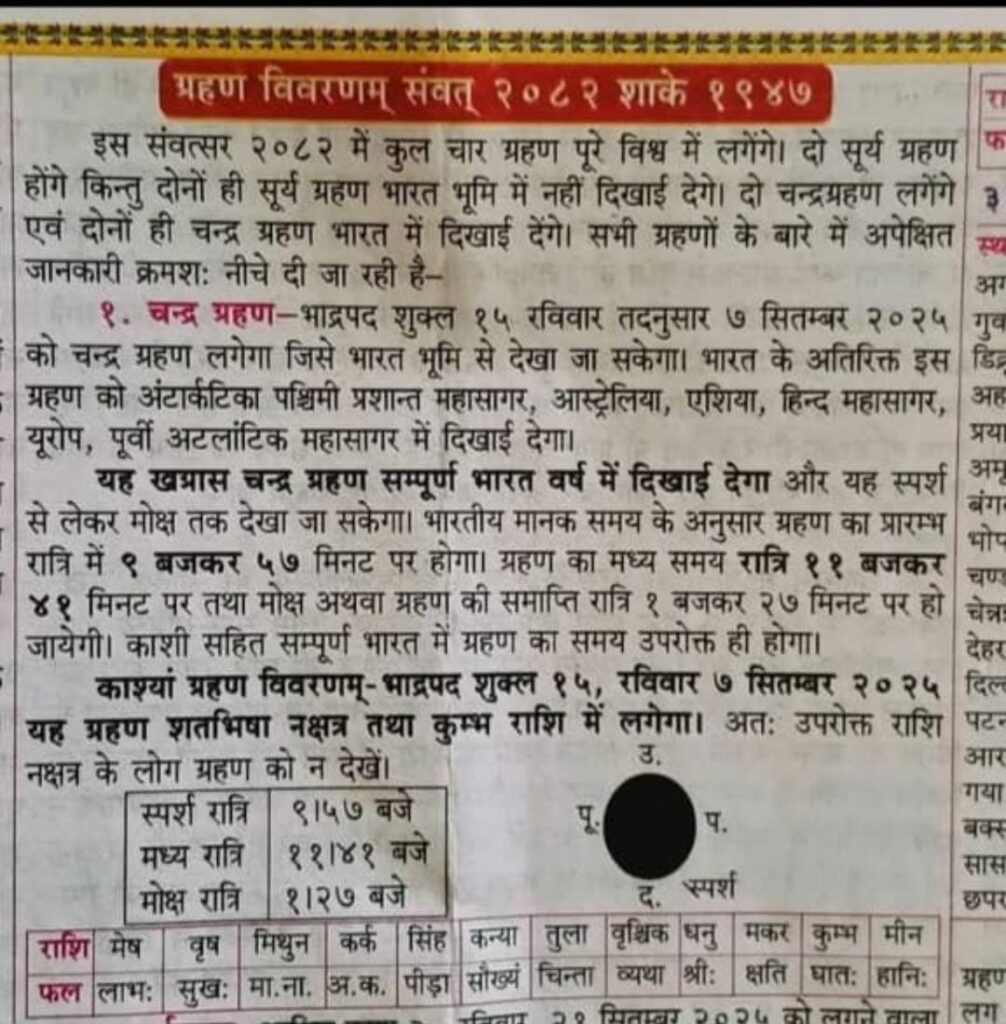Chandra Grahan 7 September 2025: Significance, Timings, and Impact The mysteries of the cosmos have always fascinated humanity, and one of the most captivating celestial events is the Chandra Grahan, or Lunar Eclipse. On 7th September 2025, the world will witness a remarkable Chandra Grahan that will not only intrigue astronomers but also hold spiritual, cultural, and astrological importance across many communities.
In India, lunar eclipses are deeply embedded in cultural traditions. They are observed with rituals, fasting, prayers, and scientific curiosity. Let us dive into the details of the 7 September 2025 lunar eclipse, its visibility, significance, and how it affects us.

Table of Contents
What is a Chandra Grahan?
A Chandra Grahan (Lunar Eclipse) occurs when the Earth comes between the Sun and the Moon, casting its shadow on the Moon. This alignment blocks sunlight from reaching the Moon directly, giving it a mysterious appearance.
There are three types of lunar eclipses:
- Total Lunar Eclipse – The Moon is fully covered by Earth’s shadow, turning it a deep red, often called the “Blood Moon.”
- Partial Lunar Eclipse – Only a portion of the Moon enters Earth’s shadow.
- Penumbral Lunar Eclipse – A subtle shadow falls on the Moon, which may be difficult to notice with the naked eye.
The eclipse on 7 September 2025 will be a Total Lunar Eclipse, visible in several parts of the world, including India. Chandra Grahan 7 September 2025: Significance, Timings, and Impact
Chandra Grahan 7 September 2025: Timings and Visibility
According to astronomical calculations, the Chandra Grahan on 7 September 2025 will be visible across Asia, Africa, Europe, South America, and Australia. In India, the eclipse will be clearly observable if the skies are clear. Chandra Grahan 7 September 2025: Significance, Timings, and Impact
Approximate Timings in India (IST):
- Penumbral Eclipse Begins: 05:57 AM
- Partial Eclipse Begins: 06:56 AM
- Total Eclipse Begins: 08:13 AM
- Maximum Eclipse: 08:45 AM
- Total Eclipse Ends: 09:17 AM
- Partial Eclipse Ends: 10:34 AM
- Penumbral Eclipse Ends: 11:33 AM
(Timings may vary slightly depending on the location.)
The Science Behind the Lunar Eclipse
From a scientific perspective, a lunar eclipse is a natural astronomical event that provides valuable insights into the Earth-Moon-Sun relationship. Unlike solar eclipses, lunar eclipses are safe to observe with the naked eye.
- During the eclipse, the Moon appears reddish due to Rayleigh scattering — the Earth’s atmosphere filters sunlight, allowing only red wavelengths to reach the Moon’s surface.
- Scientists use eclipses to study the Earth’s atmosphere and its dust, pollution, and cloud patterns.
- They also help in understanding orbital mechanics and fine-tuning astronomical predictions.
Thus, while eclipses are viewed spiritually in India, they are also moments of scientific wonder.
Cultural and Religious Significance of Chandra Grahan
In Indian tradition, lunar eclipses are considered highly significant. The scriptures describe eclipses as a cosmic event involving Rahu and Ketu, shadow planets that “swallow” the Moon. Chandra Grahan 7 September 2025: Significance, Timings, and Impact
Rituals Followed During Chandra Grahan in India:
- Fasting (Upvaas) – Many devotees observe fasts during the eclipse.
- Sutak Period – A period of about 9 hours before the eclipse is considered inauspicious. Temples remain closed, and auspicious activities like weddings, new ventures, or pujas are avoided.
- Mantra Chanting – Reciting mantras such as the Maha Mrityunjaya Mantra or Gayatri Mantra during the eclipse is believed to remove negative energies.
- Bath and Donation (Snan & Daan) – Taking a holy bath after the eclipse and donating food, clothes, or money is considered highly auspicious.
- Pregnant Women Precautions – Traditionally, pregnant women are advised to avoid going outdoors during the eclipse as a precautionary measure.
These beliefs highlight the spiritual significance of eclipses in Indian culture.
Astrological Impact of Chandra Grahan 2025
Astrologically, eclipses are believed to influence human lives, depending on planetary alignments and zodiac signs. The Chandra Grahan of 7 September 2025 falls in the Pisces (Meena Rashi) sign.Chandra Grahan 7 September 2025: Significance, Timings, and Impact
Possible Effects on Zodiac Signs:
- Aries: Emotional fluctuations, need to control anger.
- Taurus: Financial caution advised, avoid unnecessary spending.
- Gemini: Opportunities for personal growth, but avoid conflicts.
- Cancer: Focus on health and family harmony.
- Leo: Career changes possible, stay patient.
- Virgo: Spiritual awakening, chance for learning.
- Libra: Mixed results in relationships, maintain balance.
- Scorpio: Stress in partnerships, practice calmness.
- Sagittarius: Positive changes in career, but stay grounded.
- Capricorn: Family matters need attention, avoid disputes.
- Aquarius: Good time for creativity and innovation.
- Pisces: Most affected – time for self-reflection and inner growth.
(Astrological predictions are beliefs and should be taken as guidance, not absolute outcomes.)
Dos and Don’ts During Chandra Grahan
Do’s:
- Chant mantras and meditate for spiritual energy.
- Take a holy bath before and after the eclipse.
- Donate food and essentials to the needy.
- Keep food and water covered during the eclipse.
Don’ts:
- Avoid eating or drinking during the eclipse.
- Do not perform any auspicious rituals.
- Pregnant women should avoid using sharp objects or stepping out.
- Avoid making important financial or business decisions .Chandra Grahan 7 September 2025: Significance, Timings, and Impact
Scientific vs. Traditional Beliefs
It is important to understand the balance between science and tradition. While science explains the eclipse as a natural event with no harmful physical effects, cultural traditions associate it with energy shifts.
- Science says – There is no evidence that eclipses harm food, water, or pregnant women.
- Tradition says – Following rituals during an eclipse brings peace and removes negativity.
Respecting both perspectives allows people to experience the eclipse as both a scientific wonder and a spiritual journey.
How to Safely Watch the Chandra Grahan
Unlike solar eclipses, lunar eclipses are completely safe to observe with the naked eye. You don’t need any special glasses.
- Find an open area with a clear view of the sky.
- Use binoculars or a telescope for a detailed view.
- Capture the moment with a camera – lunar eclipses are great for astrophotography.
- Join local astronomy clubs or observatories for guided eclipse viewing.
This makes the 7 September 2025 eclipse a great opportunity for students, researchers, and sky enthusiasts.
Why Chandra Grahan Fascinates Humanity
Lunar eclipses have fascinated humans for centuries. Ancient civilizations often considered them as omens, while modern science sees them as natural phenomena.
- They remind us of the vastness of the universe and our small yet significant place in it.
- They inspire curiosity and wonder, pushing us to learn more about space.
- They bring together science, spirituality, and culture, making them unique events where tradition and astronomy meet.
Conclusion
The Chandra Grahan of 7 September 2025 is not just an astronomical event but also a spiritual and cultural occasion. For scientists, it is an opportunity to study the mysteries of the cosmos. For devotees, it is a time of prayer, discipline, and rituals. For sky-watchers, it is a breathtaking spectacle.
As the Moon turns red and the Earth’s shadow embraces it, let us remember that eclipses symbolize change, renewal, and the eternal bond between the Sun, Earth, and Moon. Whether you view it through the lens of science or spirituality, the upcoming Chandra Grahan is sure to leave an everlasting impression.
So, mark your calendars for 7 September 2025 – a night when the universe will once again remind us of its infinite beauty and mysteries. Chandra Grahan 7 September 2025: Significance, Timings, and Impact

